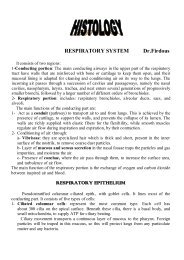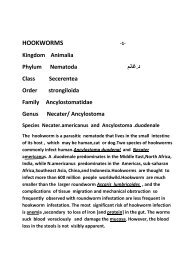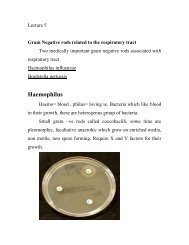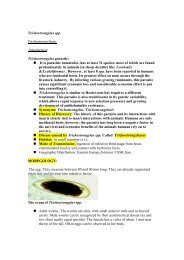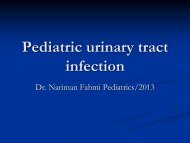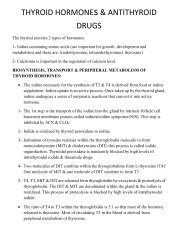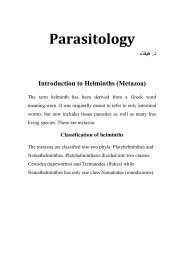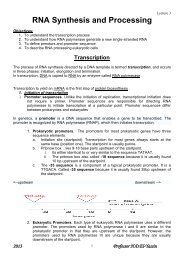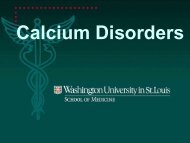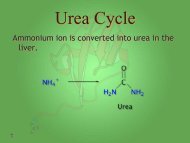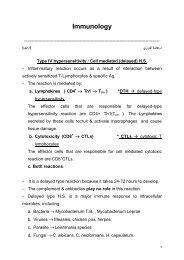Phenomenology, psychopathology in psychiatry
Phenomenology, psychopathology in psychiatry
Phenomenology, psychopathology in psychiatry
- No tags were found...
You also want an ePaper? Increase the reach of your titles
YUMPU automatically turns print PDFs into web optimized ePapers that Google loves.
<strong>Phenomenology</strong>,<strong>psychopathology</strong> <strong>in</strong><strong>psychiatry</strong>Dr Maha s YounisAssistant professor <strong>in</strong> <strong>psychiatry</strong>
Signs and symptomsabnormal emotions- 1abnormal th<strong>in</strong>k<strong>in</strong>g-2abnormal movements-3abnormal speech-4abnormal consciousness- 5Consciousness ;state of awarenessfull-alert ,vigil-cloudy-<strong>in</strong>complete clear –m<strong>in</strong>dedness with disturbance <strong>in</strong> perception -and attitudesTwilight state ; disturbed consciousness with halluc<strong>in</strong>ationsstupor;lack of reaction to surround<strong>in</strong>gs-(loss –comma ,comma vigil (ready to be aroused-
Disturbance of attention : attention is the amount of effortexerted <strong>in</strong> focus<strong>in</strong>g on certa<strong>in</strong> portions of an experienceConcentration :,ability to susta<strong>in</strong> a focus on one activityDistractibility ;<strong>in</strong>ability to concentrate•Selective <strong>in</strong>attention : block<strong>in</strong>g out only th<strong>in</strong>gs thatgenerate anxiety•
It’s a complex feel<strong>in</strong>g state with psychic ,somatic,and behavioral components that is related toaffect and mood .Affect ; observed expression of emotion ,may be<strong>in</strong>consistent with patients description of emotionmood : Is a pervasive and susta<strong>in</strong>ed emotion,subjectively experienced and reported by thepatient and observed by others\,like depression.,elation ,anger
Affect and moodAppropriate affect ; condition <strong>in</strong> which the emotional tone is <strong>in</strong> •(.harmony with the accompany idea ,thought, or speech (full affectIn appropriate affect ;disharmony between the emotional feel<strong>in</strong>g - •.tone and the idea ,thought ,or speech accompany<strong>in</strong>g itBlunted affect ; a disturbance <strong>in</strong> affect manifested by a sever - •.reduction <strong>in</strong> the <strong>in</strong>tensity of toneRestricted affect ;reduction <strong>in</strong> <strong>in</strong>tensity of feel<strong>in</strong>g tone less sever - •than blunted affect but clearly reducedflat affect ; absence or near absence of any signs of affective - •expression ;voice monotonous ,face immobilelabile affect ;rapid and abrupt changes <strong>in</strong> emotional feel<strong>in</strong>g tone - •unrelated to external stimuli
MoodDysphoric mood : unpleasant •euthymic mood ;normal range of mood ,not depressed -not elevated moodExpansive mood ;expression of ones feel<strong>in</strong>gs without -resra<strong>in</strong>t,frequently with an overestimation of onessignificance or importanceIrritable mood ;easily annoyed and provoked to angermoodsw<strong>in</strong>gs ; rapid changes between high and low-Euphoria ; <strong>in</strong>tense elation with feel<strong>in</strong>gs of grandeurdepression;psychopathological feel<strong>in</strong>gs of sadness-Anhedonia; loss of <strong>in</strong>terest <strong>in</strong> and withdrawal from all -regular and pleasurable activities often associated withdepression•
Disorders of th<strong>in</strong>k<strong>in</strong>g;Disorders of th<strong>in</strong>k<strong>in</strong>g process •disturbance <strong>in</strong> the form of thought- •loos<strong>in</strong>g of association; flow of thought <strong>in</strong> which ideas shift from one subject to -•another <strong>in</strong> a completely unrelated wayDerailment ; gradual or sudden deviation <strong>in</strong> tra<strong>in</strong> of thought without block<strong>in</strong>g- •flight of idea ;rapid ,cont<strong>in</strong>uous play <strong>in</strong> the words that produce shift<strong>in</strong>g of ideas - •apparently connectedBlock<strong>in</strong>g ; abrupt <strong>in</strong>terruption <strong>in</strong> tra<strong>in</strong> of th<strong>in</strong>k<strong>in</strong>g before a thought or idea is f<strong>in</strong>ished- •Neologism; new word created by the patient, often by comb<strong>in</strong><strong>in</strong>g syllables of about - •other words ,for idiosyncratic psychological reasonsword salad; <strong>in</strong>coherent mixture of word and phrases- •Circumstantiality‘ ; <strong>in</strong>direct speech that is delayed <strong>in</strong> reach<strong>in</strong>g the goal- •-•
Tangentiality ; <strong>in</strong>ability to have goal-directed -associations of thought<strong>in</strong>coherence ; non understandable ,no logical -connection result<strong>in</strong>g <strong>in</strong> disorganization-perseveration ; persist<strong>in</strong>g response to a priorstimulus after a new stimulus has beenpresented ,often associated with cognitivedisorders• -• -•••
Echolalia ; pathologically repeat<strong>in</strong>g words and phrases - •of one person by anotherDisturbance of contents- •Poverty of thought ; little <strong>in</strong>formation from thoughts due - •to vagueness ,obscure phrasesovervalued idea ; unreasonable ,susta<strong>in</strong>ed false or - •sometimes logical belief ,emotionally charged. can beshared by others of same groupDelusion ; fixed false belief ,based on <strong>in</strong>correct - •<strong>in</strong>ference about external reality ,not consistent withpatient <strong>in</strong>telligent and cultural back ground ,that cant bechanged by argument or reason<strong>in</strong>g
Types of delusionsBizarre delusion ;totally strange and odd-•non bizarre ;apparently logical but its false <strong>in</strong> orig<strong>in</strong> like -paranoid ,delusion of jealousy (systematized (wellformedAnother classification <strong>in</strong>to •primary ; arise suddenly without stimulation or previous -.event-secondary ;like be<strong>in</strong>g secondary to drug abuse ,delusion,of guilt result from depression•••
Types of delusionsAccord<strong>in</strong>g to its nature and formNihilistic delusion ; thoughts of non existent or end<strong>in</strong>g of body - 1,self ,othersdelusion of grandiosity ;exaggerated conception of ones - •.importance ,power ,or identitydelusion of reference ; behavior of others refers to oneself ,non-significant object or stimulus will take a personal significancedelusion of guilt ; feel<strong>in</strong>gs of remorse self accusation for imag<strong>in</strong>ed -or small mistakes•delusion of control (passivity feel<strong>in</strong>gs( ; ones will ,thoughts or -feel<strong>in</strong>gs be<strong>in</strong>g controlled by external force-paranoid delusions; pathological feel<strong>in</strong>gs of persecution which takemany presentations•••••
somatic delusion ; <strong>in</strong>volve function<strong>in</strong>g of ones body - •.organsThought <strong>in</strong>sertion ; delusion that thoughts are be<strong>in</strong>g - •implanted <strong>in</strong> ones m<strong>in</strong>d by others or external forcethought withdrawal ; thoughts are be<strong>in</strong>g removed from - •the bra<strong>in</strong>thought broadcast<strong>in</strong>g ; ones thought can be heard by - •others like broad cast<strong>in</strong>g <strong>in</strong> the airdelusion of love (erotomania( ; be<strong>in</strong>g loved by someone - •who is usually difficult to be approacheddelusion of <strong>in</strong>fidelity ,delusional jealousy ;false thought - •of spouse or partner unfaithfulness- •
Disorders of perceptionTransferr<strong>in</strong>g physical stimulus <strong>in</strong>to psychological •<strong>in</strong>formationHalluc<strong>in</strong>ation; false sensory perception not associatedwith real external stimuli;Types •; Auditory halluc<strong>in</strong>ation •Visual- •olfactory- •gustatory- •Tactile- •(somatic (<strong>in</strong>ner perception- ••
Types of halluc<strong>in</strong>ationsHypnagogic halluc<strong>in</strong>ation ; while fall<strong>in</strong>g asleep-Hypnopompic halluc<strong>in</strong>ation ; while awaken<strong>in</strong>g-••Mood congruent ; <strong>in</strong> which the contents are consistentwith either depressed or elevated moodmood <strong>in</strong> congruent ; <strong>in</strong> which the content is not - •consistent with the moodPseudo halluc<strong>in</strong>ation – imag<strong>in</strong>ary halluc<strong>in</strong>ation that’sassociated with emotional state and the patient is unsure of its source usually of short duration••
Disorders of motor movementsEchopraxia ; pathological imitations with another'smovement•catatonia ; low or limited mobility constantly ma<strong>in</strong>ta<strong>in</strong>ed-Stereotypy; repetitive fixed pattern of physical action or -speechMannerism ; habitual repetitive <strong>in</strong>voluntary movements -that has significant mean<strong>in</strong>gNegativism; resistance to all attempt to be moved by -<strong>in</strong>structionsPsychomotor agitation ; excessive motor overactivityassociated with <strong>in</strong>ner tension•••••



